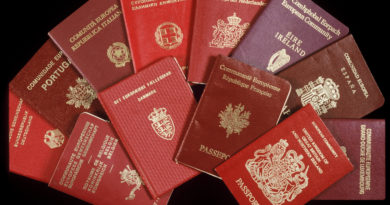[Updated] “Settled status” headache: updating details after passport renewals
EU citizens who have acquired “settled status” in the UK have to update their personal details every time they change the passport or identity card they used to apply, the Home Office requires. They also have to update UK address, phone number or email, whenever they change.
The EU settlement scheme (or “settled status”) was designed to replace the EU’s permanent residence system after the UK exit from the European Union. It is meant to confirm residence and social security rights in the UK of citizens from the European Union (EU), Norway, Iceland, Liechtenstein and Switzerland, and their family members.
These groups can apply via a digital app using their passport or ID number. At the end of the process, a letter from the Home Office confirms the decision about the status and provides the link to a web page that contains all the details.
Through the web page a share code is provided to prove the legal status to others, for example employers or landlords. This web page can be accessed with the passport or ID number used in the application and the user’s date of birth.
You may be required to prove your status in order to demonstrate your right to work, or to access benefits and services, for example to prospective employers and landlords, the National Health Service (NHS), other Government departments and local authorities.
Home Office settled status confirmation letter.
The deadline to apply for “settled status” is 30 June 2021 under the withdrawal agreement negotiated with the EU. By the end of June 2019, 805,000 people were granted settled or pre-settled status. By the end of January 2020, the number had reached 2.7 million, the Home Office reports.
For some of them, the document used in the application may have expired or have been replaced. What to do in such cases?
How to update passport details
The system does not send a reminder if an identity document has expired, so it is up to users to remember to update the details. Initially, this could be done via the online profile and sending the new passport or identity card to the Home Office for verification.
Robert M. from Edinburgh (he chose not to disclose his full name) went through the process and was left with many questions. A retired professor who has lived in the UK for 32 years, Robert applied for settled status during the trial phase for university employees, in November 2018.
“I found the process surprisingly easy. It all went very smoothly and I got the ‘settled status’ confirmation within 24 hours,” he told Europe Street. “But my German passport expired at the end of December so I had to update the online status when I received the new passport in January.”
When he applied for settled status, Robert did not know that this would be linked to his passport number. He would have applied anyway because he was “keen to participate in the trial” as this was done “under tighter supervision”, he said. But nowhere during the application was he informed that he would need to update the details after the passport renewal.
After contacting the Home Office, he sent the passport in by post and received it back “within 12 days with a note that the Home Office had taken notice.”
Further correspondence seen by Europe Street, however, shows that by mid-July the log in only worked using the old passport number. The Home Office explained the delay with the “exceptionally large number of new applications” and told Robert it was “unable to give a timescale for when these details will be updated.”
The Home Office reassured Robert that this would not have any effect on his application to become a British citizen, as he was planning to do. But what about potential work contracts, Robert asked? “This is just another of the pitfalls of the settled status scheme that no one had envisaged before,” he said.
Barbara Drozdowicz, CEO of the East European Resource Centre (EERC), an organisation supporting East Europeans in the UK, told Europe Street that questions around passport renewals are common among individuals who enquire about the scheme.
“The need to send new passports or ID cards to the Home Office is a problem, especially for people who travel or live abroad,” she said. “Having ‘settled status’ allows to spend a period of time outside the country and people who have jobs elsewhere would not want to send their passports by post,” Ms Drozdowicz added.
New online function
Contacted by Europe Street in July 2019, the Home Office said that while new ID documents have to be sent in for verification, the online system would soon allow to make the changes through the “Update My Details” function.
“We are currently working on delivering a fast, secure and user friendly process for applicants to add new ID documents to their status profile through an entirely online process and expect this service to be available later this summer,” the Home Office said.
Contacted for an update in February 2020, following information from readers that the online update option was not available yet, the Home Office told Europe Street the new system was expected to become available “in the coming months, following extensive user testing.”
In July 2019, the Home Office also clarified that the settled status does not depend on the ID document it is associated to.
In February 2020 the Home Office added: “It is not necessary for EU citizens and their families to update new ID document until free movement ends on 31 December 2020.”
The digital update option became available in September 2020. It is now possible to update passport and ID details, as well as name, UK address, telephone number and email directly on the government website at the page “Update your EU Settlement Scheme details” or through the page “View and prove your settled or pre-settled status”.
We have gone through the process on September 4.
Users need to have access to a mobile phone or email address while going through the process, to get a security code to confirm the identity.
They have to answer some questions with relevant data. At the end of the process, the screen says: “We’ll check the information you have given. This usually takes around 7 days. We’ll then contact you by email to confirm your update, or to let you know if there’s a problem.”
It took a bit longer than expected, but on September 28 the email confirming the changes has arrived.
The website says that until the update is confirmed, the old identity document details should be used to access the online status.
It is not possible to update the details if a users has not yet received confirmation of status.
Settled status system updates
In the summer of 2019, the Home Office planned other updates of the settled status system.
The ‘Update my Details’ service now allows users to change their photos.
It is possible to convert pre-settled status to settled status online. (Pre-settled status is acquired when a person has lived in the UK for less than five years and guarantees fewer rights than settled status.)
The app to self-verify the applicants’ identity, which used to work only on Android phones, is now available on Apple devices too.
Demands for a physical document
Despite the improvements to the online system, the EERC and EU citizens’ rights groups such as the3million insist that a physical document should be issued to EU and EEA nationals to prove their legal status in the UK.
At a meeting of the House of Lords EU Justice sub committee in July 2019, Baroness Sarah Ludford asked the Home Office to offer the option at least to people who request it.
Immigration Minister Caroline Nokes, however, rejected the idea. “EEA nationals already get a letter confirming their status but that’s not a secure document, and we believe that the digital route provides the most secure means for somebody to evidence their rights to access services in the UK,” she said.
Claudia Delpero © all rights reserved.
Photo: “Europe Direct” contact centre, an information service provided in all languages by the European Union. Photo by Lukasz Kobus © European Union, 2019, Source: EC – Audiovisual Service.
This article was first published on July 22, 2019. It was updated following readers’ messages on February 19, 2020, with the response from the Home Office on February 23, 2020, with the confirmation that the digital update is available on September 5, with delays on September 22, and with final confirmation on September 28, 2020.





